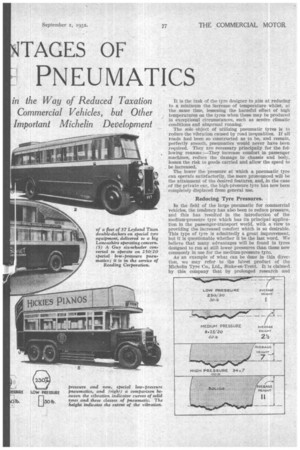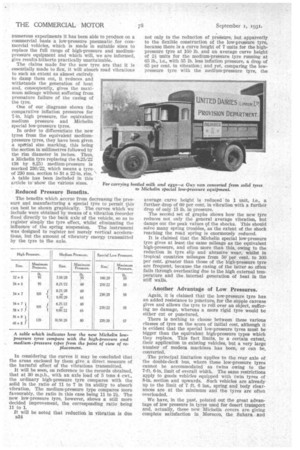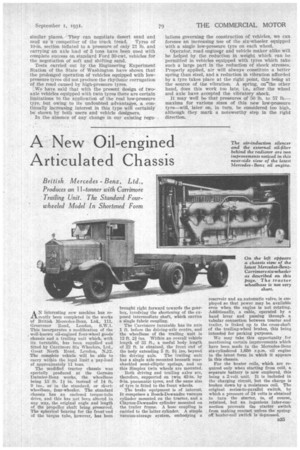THE ADVA
Page 50

Page 51

Page 52

Page 53

If you've noticed an error in this article please click here to report it so we can fix it.
TAGES OF
Low-PRESSUM PNEUMATICS
Not Only are Special Concession and Increased Speed Allowed fi Definite Benefits Accrue. An • in the Way of Reduced Taxation Commercial Vehicles, but Other Important Michelin Development
ONE of the most vital factors in the development of the modern, high-speed, smooth-riding commercial vehicle is the pneumatic tyre, and its advantages, both as regards the machine and the roads, have been recognized by the Government, the Ministry of Transport having made special concessions to operators whose vehicles are equipped throughout with pneumatic tyres, these being a 20 per cent. reduction of the tax, an increase in the limit of speed, and special alloWances for overall width to permit the conversions from solids to piaehmatics.
Matters have progressed so far that no operator of passenger vehicles—and we believe this would also apply to goods vehicles—would consider for a moment returning to the use of solid tyres. Even steam wagons are now provided with this new tyre equipment.
Functions of the Pneumatic Tyre.
When considering the functions which have to be performed by the tyres, it must be remembered that the whole work of transmission has to be borne by them. In addition, they must support static and live loads and absorb shocks arising from the traversing of uneven road surfaces. A true pneumatic tyre performs these functions satisfactorily by virtue of its ability to flex, which enables it to absorb many shocks while preserving the smooth transmission of power.
As a result of this work, energy is generated in the tyre and must be dissipated as heat. This, heat is harmful and must be kept as low as possible. It occurs in spite of rubber impregnation of the cords of' the fabric, although this reduces considerably the amount of heat by lessening the internal friction. llowever, the temperature increases rapidly with extra loads, higher speeds, rapid acceleration and fierce braking, and is particularly noticeable after long runs without stops. It is the task of the tyre designer to Aim at reducing to a minimum the increase of temperature whilst, at the same time, lessening the harmful effect of high temperatures on the tyres when these may be produced in exceptional circumstances, such as severe climatic conditions and abnormal running.
The sole object of utilizing pneumatic tyres is to reduce the vibration caused by road inequalities. If all roads had been so constructed as to be, and remain, perfectly smooth, pneumatics would never have been required. They are necessary principally for the following reasons :—They increase comfort in passenger machines, reduce the damage to chassis and body, lessen the risk to goods carried and allow the speed to be increased, The lower the pressure at which a pneumatic tyre can operate satisfactorily, the more pronounced will he the attainment of the desired features, and, in the ease of the private car, the high-pressure tyre has now been completely displaced from general use.
Reducing Tyre Pressures.
In the field of the large pneumatic for commercial vehicles, the tendency has also been to reduce pressure, and this has resulted in the introduction of the tuediuna-pressure tyre which has its principal application in the passenger-transport world, with a view to providing the increased comfort which is so desirable. This type of tyre is admittedly a great improvement, but it is questionable whether it be the last word. We believe that many advantages will be found in tyres designed to run at still lower pressures than those now commonly in use for the medium-pressure tyre. As an example of what can be done in this direction, we may refer to the latest product of the Michelin Tyre Co., Ltd., Stoke-on-Trent It is claimed by this company that by prolonged research and numerous experiments it has been able to produce on a
commercial basis a low-pressure pneumatic for commercial vehicles, which is made in suitable sizes to•
replace the full range of high-pressure and mediumpressure equipment and which will, we are informed, give results hitherto practically unattainable.
The claims made for the new tyre are that it is essentially made to flex, it will absorb road vibrations to such an extent as almost entirely to damp them out, it reduces and withstands the generation of heat and, consequently, gives the maximum mileage without suffering from premature failure of the casing of the tyre.
One of our diagrams shows the comparative inflation pressures for 7-in. high pressure, the equivalent medium pressure and Michelin special low-pressure tyres.
In order to differentiate the new tyres from the equivalent mediumpressure tyres, they have been given a spetial size marking, this being the section in millimetres followed by the rim diameter in inches. Thus, a Michelin tyre replacing the 8.25/22 (38 by 8.25) medium-pressure is marked 230/22, which means a tyre of 230 mm. section to fit a 22-in. rim. ' A table has been included in this article to shoo/ the various sizes.
Reduced Pressure Benefits.
The benefits which accrue from decreasing the pressure and manufacturing a special tyre to permit this can best be shown graphically. The curves which we include were obtained by means of a vibration recorder fixed directly to the back axle of the vehicle, so as to register simply the tyre effect, whilst eliminating the influence of the spring suspension. The instrument was designed to register not merely vertical accelerations, but the amount of vibratory energy transmitted by the tyre to the axle.
In considering the curves it may be concluded that the areas enclosed by them give a direct measure of the harmful effect of the vibrations transmitted.
It will be seen, on reference to the records obtained, that at SO m.p.h., with an axle load of 5 tons 4 cwt., the ordinary high-pressure tyre compares with the solid in the ratio of 11 to 7 in its ability to absorb vibration. The medium-pressure type compares more favourably, the ratio in this case being 11 to 2. The new low-pressure tyre, however, shows a still more decided improvement, the corresponding ratio being 11 to 1.
It will be noted that reduction in vibration is due B34
not only to the reduction of pressure, but apparently to the flexible construction of the low-pressure tyre, because there is a curve height of 7 units for the highpressure tyre at 100 lb. and an average curve height of 21. units for the medium-pressure tyre running at 65 lb., i.e., with 35 lb. less inflation pressure, a drop of 65 per cent. in vibration ; and yet, comparing the lowpressure tyre with the medium-pressure tyre, the
average curve height is reducedto 1 unit, i.e., a further drop of 60 per cent. in vibration with a further drop of only 15 lb. in pressure.
The seccind set of graphs shows how the new tyre reduces not only the general average vibration, but damps out the peak values of the shocks. This should solve many spring troubles,, as the extent of the shock reaching the road spring is enormously reduced.
It is claimed that the Michelin special low-pressure Lyre gives at least the same mileage as the equivalent high-pressure, and often more than this, owing to the. reduction in tyre slip and abrasive wear, whilst in tropical countries mileages from 50per cent. to 100 per cent, greater than those of the high-pressure tyre are frequent, because the casing of the latter so often fails through overheating due to the high external temperature and the internal generation of heat in the stiff walls.
Another Advantage of Low Pressures.
Again, it is claimed that the low-pressure tyre has an added resistance to puncture, for the supple carcase gives and allows the tyre to roll over an object, suffering no damage, whereas a more rigid tyre would be either cut or punctured.
There is nothing to choose between these various classes of tyre on the score of initial cost, although it is evident that the special low-pressure tyres must be bigger, than the equivalent high-pressure types which they replace. This fact limits, to a certain extent, their application to existing vehicles, but a very large number of modern machines has been, or can be, converted.
-The principal limitation applies to the rear axle of the double-deck bus, where these low-pressure tyres cannot be accommodated as twins owing to the 7-ft. 6-in, limit of overall width. The same restrictions apply to goods vehicles equipped with twin tyres of 8-in. section and upwards. Such vehicles are alreadylip to the limit of 7 ft. 6 ins., spring and body clearances are at the minimum and the tyres are often overloaded.
We have, in the past, pointed out the great advantit.b% of low pressure in tyres used for desert transport and, actually, these new Michelin covers are giving complete satisfaction in Morocco, the Sahara and
similar places. They can negotiate desert sand and mud as a. competitor of the track tread. Tyres of 10-in. seetiOn inflated to a pressure of only 21 lb. and carrying an axle load of 3 tons have been used with complete success on standard Ford 30-cwt. vehicles for the negotiation of soft and shifting sand.
Tests carried out by the Engineering Experiment Station of the State of Washington have shown that the prolonged operation of vehicles equipped with lowpressure tyres did not produce the rhythmic corrugation Of the road caused by high-pressure tyres.
"We have said that with the present design of two-, axle vehicles equipped with twin tyres there are certain limitations to the application of the real low-pressure tyre, but owing to its undoubted advantages, a continually increasing interest in this type, will certainly be. shown by both users and vehicle designers.
• In the absence of any change in our existing regu lations governing the construction of vehicles, we can foresee an increasing use of the six-wheeler equipped with a single low-pressure tyre on each wheel.
Operator, road enginer and vehicle maker alike will be helped by the reduction in weight which can be permitted in vehicles equipped with tyres which take such a large part in the reduction of shock stresses. Properly applied, air will always constitute a better spring than steel, and a reduction in vibration afforded by a tyre takes place at the right point, this being at the source of the vibration. A spring, on–the other hand, does this work too late, i.e., after the wheel and axle have accepted the vibratory shock.
It may well be that pressures of 50th. to 57 lb.— maxima for various sizes of this new low-pressure tyre—will, later on, in turn, be considered too high, although they mark a noteworthy step in the right direction.




































































































